
* The US continued to refine the Sabre design to obtain absolute air superiority over Korea, with refinements continuing after the cease-fire. The F-86 would be a major weapon in the early years of the Cold War, assigned to roles including reconnaissance, air defense, and nuclear strike.
* The XF-86C / XF-93 had been a major departure from the F-86A, and a dead end. However, NAA also developed a more evolutionary enhancement of the F-86A, in the form of the "F-86E".
The F-86E was difficult to distinguish from the F-86A, but featured improved flight controls, an uprated J47-GE-13 engine with 24.2 kN (2,470 kgp / 5,450 lbf) thrust, and an "all-moving tail" or "all-flying tail" with hydraulic actuators. In the F-86A, the tailplane was fixed, but with the all-flying tail the entire tailplane assembly could be rotated; the moving elevator was retained. The all-flying tail was introduced because the original tailplane became ineffective at transonic speeds, with pilots having difficulty pulling out of high-speed dives; the all-flying tail provided much better control authority at such speeds. The hydraulic actuation system meant that the elevators no longer provided any force feedback to the pilot, but NAA engineers devised an "artificial feel" mechanism, using bungee connections and counterweights.
The first F-86E flew on 23 September 1950, once again with George Welch at the controls. The first production batch of 60 "F-86E-1s" began to flow to fighter groups in early 1951, replacing war-weary F-86As in combat beginning in the spring. The next batch was of 51 "F-86E-5s", which were identical except for some tweaky changes in switches and the like.
The third batch of 60 "F-86E-6s" was actually built by Canadair of Canada. Canadair had signed a license agreement with NAA to build the Sabre, and the USAF took advantage of the arrangement to use Canadair as a second source. The F-86E-6, or "F-86E-6-CAN" as it was sometimes called, was essentially a Canadair Sabre Mark 2, discussed later.
* There wasn't supposed to be a fourth batch of F-86Es, since production was planned to move on to the "F-86F" powered by the uprated J47-GE-27 engine with kN 27.1 kN (2,760 kgp / 6,090 lbf) thrust. However, GE couldn't deliver the new engine in time, so NAA went ahead and fitted the F-86F airframe with the current J47-GE-13 engine. The result was the "F-86E-10", and 132 were built beginning in September 1951. Since they had been designed to accommodate the J47-GE-27 engine, some were retrofitted with the more powerful engine in the field. There would actually be another unplanned E-series variant, discussed below.
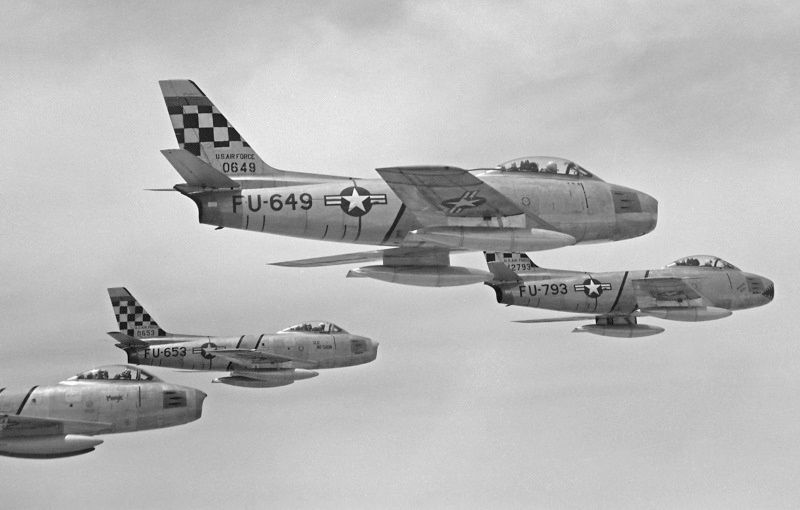
* The first proper "F-86F-1" with the J47-GE-27 engine flew in March 1952. The new engine fit provided a significant improvement in performance, particularly in terms of rate of climb. 78 were built, with operational deliveries beginning in June 1952.
The F-86F-1 was followed by 16 "F-86F-5s", which featured a stronger pylon attachment point on each wing to allow the fighter to carry 758-liter (200 US gallon) drop tanks, providing extended range and combat endurance. The next production batch consisted of 34 "F-86F-10s" with the new A-4 gunsight, replacing the less reliable A-1CM gunsight.
The "F-86F-15" featured a redesign to the hydraulics system, which had proven vulnerable to battle damage, with a single hit capable of disabling the aircraft. However, only seven F-86F-15s were built because of problems with delivery of the J47-GE-27 engine. As a result, NAA then completed 100 of the variant with the J47-GE-13 engine, redesignating it the "F-86E-15". This was the last of 404 F-86Es, including the prototype.
The F-86F would prove to be the definitive production variant of the Sabre. By this time, the refinements to the Sabre had produced a fighter that was termed "viceless" by the men who flew it. For example, the Sabre had to be forced into a spin, and could be returned to stable flight simply by neutralizing the controls.
___________________________________________________________________
NORTH AMERICAN F-86F SABRE:
___________________________________________________________________
wingspan:
11.31 meters (37 feet 1 inch)
wing area:
26.75 sq_meters (288 sq_feet)
length:
11.44 meters (37 feet 6 inches)
height:
4.5 meters (14 feet 9 inches)
empty weight:
4,940 kilograms (10,890 pounds)
loaded weight:
9,234 kilograms (20,357 pounds)
max speed at altitude:
965 KPH (600 MPH / 520 KT)
service ceiling:
14,630 meters (48,000 feet)
range, with drop tanks:
1,490 kilometers (925 MI / 805 NMI)
___________________________________________________________________
The demand for F-86Fs was so great that NAA couldn't keep up with production at the Inglewood, California, plant, and so the company leased a factory from Curtiss in Columbus, Ohio, that had been used to build Helldiver dive-bombers, but had been shuttered since the end of World War II. The NAA Columbus plant began Sabre production with 100 "F-86F-20s", the first flying in March 1952. The F-86F-20 was almost identical to the F-86F-15s from Inglewood, differing only in minor changes to radio fit. The USAF gave Inglewood Sabres an "NA" suffix and Columbus Sabres an "NH" suffix -- for example, "F-86F-15-NA" versus "F-86F-20-NH".
* The next improvement in the F-86F was to make it a better fighter-bomber by adding an extra set of stores pylons, one at the midpoint of each wing, for a total of four. This "dual store" wing allowed the Sabre to carry two drop tanks and two 450-kilogram (1,000-pound) bombs. 859 of this subvariant were built by Inglewood as the "F-86F-30-NA", while 600 were built by Columbus as the "F-86F-25-NH". The first was rolled out in October 1952; they were rushed to Korea to replace outmatched North American F-51 Mustangs and Lockheed F-80 Shooting Stars in close-support units.
North American had only begun tinkering with the wing, however. Aerodynamic studies had shown that eliminating the leading-edge slat and providing a sharper leading edge on the wing provided substantial benefits in high-speed flight, though this led to "hotter" landing characteristics. To compensate for the hot landings, the wing was extended 15 centimeters (6 inches) at the root and 7.6 centimeters (3 inches) at the wingtip. The new wing, which also featured fuel tanks in the leading edge that increased capacity by 264 liters (70 US gallons), was known as the "solid 6-3" wing. The wing was incorporated into F-86F-25/30 production in midstream, and was sent to Korea in kit form to upgrade most F-86Fs and a few F-86Es in service there.
* Once the USAF got the new and better F-86F into the skies over Korea, the service decided to demonstrate the superiority of the Sabre once and for all. In the summer of 1953 the USAF had a "turkey shoot" against Communist pilots that proved once and for all who was the boss. The final tally for the entire war was estimated by the USAF as 800 MiGs lost to Sabres, with 80 Sabres lost to MiGs, a 10:1 kill ratio. 30 other Sabres were lost in combat, and 114 more were lost to accidents. Even assuming that the MiG losses were exaggerated by a factor of two, that still made the Sabre the clear winner of the contest. If the war on the ground ended in a stalemate, the USAF had reason to feel pleased with themselves in the air.
Although refinements of the aircraft helped, it was still pilot training that gave the Americans the edge. Of the 40 American aces in Korea, 39 flew the F-86. Many of them had extensive World War II experience, and these 39 men tallied over 300 of the 800 MiG-15s claimed destroyed. The top-ranking aces in the war were Captain Joseph D. McConnell JR, with 16 kills; Major James Jabara, with 15 kills; and Captain Manuel "Pete" Fernandez with 14 kills. Jabara had actually been the first jet ace and was in competition with McConnell, but Jabara's eagerness got the better of him, and his 16th kill turned out to be a Sabre. The pilot escaped unharmed, though a 12.7-millimeter bullet grazed him close enough to tear open his life jacket.
McConnell was killed in an F-86 crash in 1954. He had a "Hollywood" look to him, and would have a movie made about him, with Alan Ladd in the starring role. Colonel Francis "Gabby" Gabreski, well-known P-47 Thunderbolt ace of World War II, obtained 6.5 kills in a Sabre over Korea, adding to his 31 kills against the Luftwaffe from the previous conflict.
Sabres operating in the ground-support role dropped roughly 8,000 tonnes (8,800 tons) of bombs and napalm and fired about 300 rockets. This was a modest quantity compared to the other aircraft assigned to the "mudfighter" role in the war.
* Even as the war in Korea bogged down to its inconclusive end, North American was working on new subvariants of the F-86F. The "F-86F-35-NA" was similar to the F-86F-25, but incorporated a "Low Altitude Bombing System (LABS)" for delivery of a single 545-kilogram (1,200-pound) Mark 12 atomic bomb. LABS was used to perform targeting for a "toss bombing" attack, in which the Sabre went into a climb from low altitude, released the bomb to fly upward and then fall back down on the target, while the aircraft departed the area as fast as possible to be clear before detonation. 264 F-86F-35s were built, becoming nuclear operational in January 1954. They were deployed in NATO bases to help meet the Soviet threat to Europe.
* The final production subvariant of the F-86F was the "F-86F-40", which was intended for Japanese use. Confronted by the Soviet Union, China, and North Korea in the Far East, the US finally decided to permit Japan to re-arm, though the new Japanese military services did not trace their ancestry back to Imperial Japanese military organizations, and were carefully described as "Self-Defense Forces". In fact, the Japanese adopted a clearly defensive military posture. After the disaster of the Pacific War, they had great misgivings about rebuilding their forces.
The Japanese Air Self-Defense Force (JASDF) was given the highest priority for bringing up to strength, and decided to adopt the F-86F as their first-line fighter. In July 1954, North American came to an agreement with Mitsubishi Heavy Industries of Japan, who had built the famed Zero fighter in the war, to co-produce a new version of the F-86F, the F-86F-40 -- which would be designed by NAA and supplied to Mitsubishi in kit form for assembly.
The F-86F-40 was similar to an F-86F-25/30, but incorporated a modified wing, featuring a 30-centimeter (1-foot) wingtip extension on the "6-3" wing, plus restored leading-edge slats. This wing was logically known as the "F-40" wing. The first F-86F-40 was rolled out at the Inglewood plant in October 1955. Performance matched that of the F-86-25/30, while the F-86-40 had tamer landing characteristics. The initial batch of kits had already been sent to Japan in August, with the first JASDF F-86F-40 rolled out a year later. Mitsubishi would assemble a total of 300 F-86F-40s, with the last produced in 1961.
Late Japanese production would be equipped to carry the new "Sidewinder" heat-seeking air-to-air missile (AAM), which was first test-fired in 1952. This weapon was then designated "GAR-8" by the USAF and "AAM-N-7" by the US Navy, though the type is now designated "AIM-9". These first-generation Sidewinders needed to be accurately boresighted on the target's exhaust to be effective. They provided an audio signal to the pilot through his earphones, in the form of a growling tone that grew louder as the missile achieved lock for firing. Sidewinders would become a common store on many late-production Sabre fighters.
In the meantime, the USAF was in a desperate need for new fighters and also decided to buy F-86F-40s, with a total of 280 built by NAA, and in addition ordered a large number of "F-40" wing kits to retrofit to older F-86Fs. These wing kits were also supplied to many US allies who used the Sabre. The F-86F-40 was the final production variant of a total of 2,538 F-86Fs built, not counting some of the unusual variants described below.
BACK_TO_TOP* The lack of killing power of the Sabre's six 12.7-millimeter Brownings was apparent both to the Soviets and the USAF. As a result, the Air Force initiated a program named "Gunval", in which an evaluation batch of Sabres were fitted with four T-160 20-millimeter revolver-type cannon. The T-160 was a derivative of a wartime German Mauser design, developed by the US Springfield Armory and NAA, to be eventually produced by Pontiac as the M-39. It would be fitted to the McDonnell F-101 Voodoo and North American F-100 Super Sabre.
A Sabre nose section was pulled out of production in early 1952 and used to test the gun fit. The nose assembly required considerable redesign to accommodate the four cannon -- not just because of their different configuration and size, but because the recoil shock was more substantial than for the Brownings, straining the gun mounts. One change that would prove significant is that to vent gun blast gases, small ports were installed in the inside of the air intake.
Ten Gunval Sabres were built and given the designation "F-86F-2". They were fitted with the four T-160 cannon, with 100 rounds per gun, with all four guns firing simultaneously. George Welch performed the test firings, and all seemed to be well. Eight Gunval Sabres were shipped to Japan in late 1952 and went into combat evaluation in early 1953.
Problems quickly cropped up. One Gunval Sabre suffered a flame-out while firing on a MiG-15, though the American pilot was able to drop to lower altitude and relight. However, a few days later another Gunval Sabre pilot had the same problem and had to eject. The Gunval Sabres were grounded. It turned out that Welch had performed the test firings at medium altitude, about 6 kilometers (20,000 feet), while air combat in Korea generally took place at much higher altitudes. In the thin air, blast gases vented into the air intake choked off airflow to the engine, causing a flame-out. The gun ports inside the air intake were welded shut, and a selector switch was installed to allow the pilot to fire two or four cannon as desired.
That helped considerably, but it still wasn't perfect. Another Gunval Sabre was lost to an engine flame-out, the pilot again ejecting safely. It turned out that the blast gases were accumulating in front of the intake, choking off airflow. An NAA field service representative devised a horseshoe-shaped clip that was installed in the muzzle troughs of the cannon to divert the blast gases away from the nose of the aircraft, finally fixing the problem.
The combat evaluation was finished in May 1953, with generally satisfactory results once the fix was in place, and the aircraft were returned to the US. Two other Sabres were fitted with four Oerlikon 206RK 20-millimeter cannon, redesignated "F-86F-3", and put through evaluation in 1954 -- but the Oerlikon cannon were heavier than the T-160s, making the aircraft nose-heavy, and were also not as reliable.
* Following a USAF request for a high-performance trainer to replace the Lockheed T-33 Shooting Star, in 1953 an F-86F was pulled from the production line for conversion to a two-seat "TF-86F" operational trainer prototypes. Initial flight was on 14 December 1953, with NAA test pilot Ray Morris at the controls. The TF-86F featured a 1.6-meter (5 feet 3 inch) fuselage stretch and tandem seating, with a single piece cockpit canopy that hinged up from the rear in a "clamshell" fashion, in contrast to the sliding canopy of most of the fighter F-86 variants. The stretch unsurprisingly shifted the aircraft's center of gravity, and so the wing was moved forward 20 centimeters (8 inches).
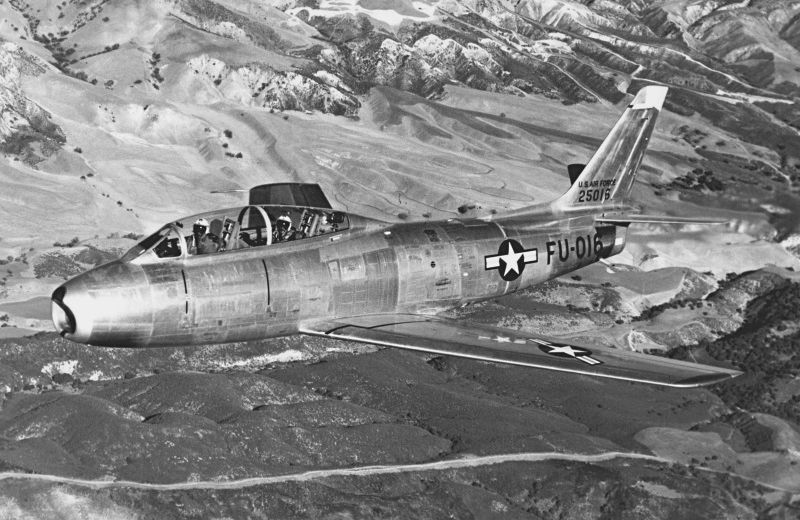
The TF-86F had short slatted wings and additional fuel tankage. No armament or gunsight were fitted. The result was that the TF-86F only weighed about 45 kilograms (100 pounds) more than a stock F-86F, and had very similar performance. Unfortunately, the TF-86F crashed on 17 March 1954, killing test pilot Joe Lynch. The Air Force ordered a second TF-86F conversion a few days later, with the aircraft making its first flight on 5 August 1954. The second TF-86F differed from the first in that it had the "F-40" long slatted wing, two 12.7-millimeter machine guns with 100 rounds per gun, and a small ventral fin under the tail. The ventral fin was added as a fix to the flight instability problem that was believed to have destroyed the first aircraft.
The second TF-86F was delivered to the Fighter School at Nellis AFB on 31 January 1955, but the program was canceled a week later, with the Air Force settling on the TF-100 Super Sabre instead. However, the second TF-86F had a long and productive life, operating at Nellis for several years as an operational trainer for Sabre pilots, and then as a chase plane at Edwards Air Force Base well into the 1960s.
BACK_TO_TOP* Since the USAF did not have a standard reconnaissance aircraft that could outrun the MiG-15, a small number of F-86As were field-modified to "RF-86A" photo-reconnaissance aircraft. This whole scheme was the brainchild of three officers of the 67th Tactical Reconnaissance Wing (TRW) at Kimpo AFB in Korea: Major Bruce Fish, Major Ruffin Gray, and Captain Joe Daley. They were told that it would be impossible to convert the Sabre to the reconnaissance role -- but they were experienced enough to recognize that this was just the military way of saying "don't bug me about it", and persisted.
They made such a nuisance of themselves around the fighter wings that they were finally given a derelict F-86A, and set about figuring out how to turn it into a reconnaissance platform. They found that there really wasn't much room for a camera, but by removing two of the 12.7-millimeter Brownings and their ammo boxes from the right side of the fuselage, they were able to squeeze in a K-25 bomb-scoring camera. The camera was mounted horizontally, but "shot" out the bottom using mirrors.
Colonel Edwin "Chick" Chickering of the 67th TRW liked the idea and managed to scrounge up two war-weary F-86As, which were then sent to Japan to be refitted with the K-25 camera. These two aircraft were known as "Honeybuckets", with the first returning to Korea in October 1951. They flew reconnaissance missions as the lead in a four-ship flight of Sabre fighters. The Honeybuckets retained four of their guns, but they were usually not loaded with ammunition, since firing the guns might knock the camera system out of alignment.
* The Honeybuckets having proven the feasibility of a reconnaissance F-86, the Air Force bureaucracy suddenly became more enthusiastic about the idea, and five more F-86As were converted to an improved reconnaissance standard under Project "Ashtray". The two Honeybuckets were also converted to the Ashtray standard. The Ashtray aircraft became "RF-86As".
All seven aircraft were fitted with two K-9 cameras. These were much larger than the K-25 camera, and so "blisters" or "cheeks" were fitted to the fuselage under the cockpit to accommodate them, with the cameras shooting through a mirror path. There were wide variations in fit. Some Ashtrays had all their guns removed, while some retained the two top guns, with ballast added to keep the aircraft's balance. Some had a small K-14 camera installed in the nose in place of the ranging radar. Some had open apertures for the cameras, while others had sliding doors -- which resembled those used in the floor ashtrays of contemporary automobiles, hence the name.
Although the Ashtray aircraft were a great improvement on the Honeybucket aircraft, Ashtray was still a field improvisation. Images were often fuzzy, partly because the mirror mounting scheme wasn't sufficiently rigid, and partly because the K-9 and later K-25 cameras weren't designed to be used by such a fast aircraft. The camera mounts were redesigned and the fast K-45 camera was eventually installed, and the RF-86As proved much more satisfactory. One RF-86A was lost in action from anti-aircraft fire in 1952, the pilot being killed.
* As with the F-86A, a number of F-86Fs were converted to a reconnaissance configuration, the "RF-86F". Three F-86F-30s were given a camera fit very similar to the Ashtray Sabres and put into action. They were known as "Haymakers".
Following this, North American built eight production RF-86Fs, featuring a much improved camera fit, including twin K-22 and a single K-14 "dicing" camera. These aircraft were also sometimes referred to as "Haymakers". The K-22s were actually mounted vertically, with new bulged fuselage panels to permit proper fit; the K-14 was fitted between them. These aircraft had no guns, but had fake gun muzzles painted on the nose as a bluff.
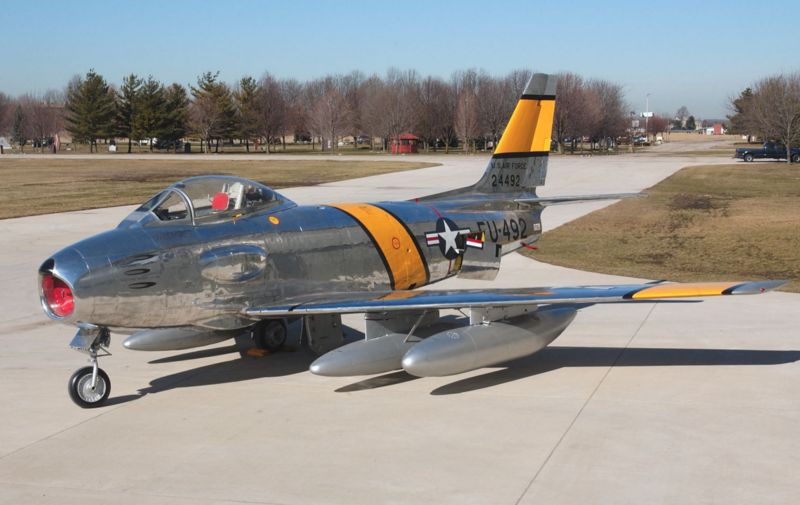
The production RF-86Fs never saw combat, but from 1954 to 1957 they performed overflights of eastern Siberia and China that remained secret for decades. The missions were approved at the presidential level. If shot down, the pilots were to tell their captors that they had got lost while performing studies of high winds aloft. Fortunately, it appears that all of them came back safely. The USAF did not obtain any more RF-86Fs, preferring the Republic RF-84F Thunderflash instead, but a number of RF-86Fs -- conversions of fighter variants -- were operated by several foreign air forces.
BACK_TO_TOP* The last fighter, as opposed to interceptor, variant of the Sabre, was the "F-86H". The "F-86G" designation was temporarily applied to an F-86D variant that never happened.
The F-86H had the classic lines of the Sabre fighter, but with a muscular appearance due to the fit of a General Electric J73-GE-3 turbojet engine with 41.2 kN (4,195 kgp / 9,250 lbf) dry thrust. The bigger engine required expansion of the intake and fuselage, with a 15-centimeter (6-inch) vertical splice to increase depth. The exhaust was extended 60 centimeters (two feet), and the tailfin was raised by 7.6 centimeters (3 inches). Other changes included fit of the "clamshell" canopy designed for the F-86D, making the F-86H the only Sabre fighter variant not to have a sliding canopy; the new ejection seat designed for the F-86D; and a unitary flat "slab" tailplane.
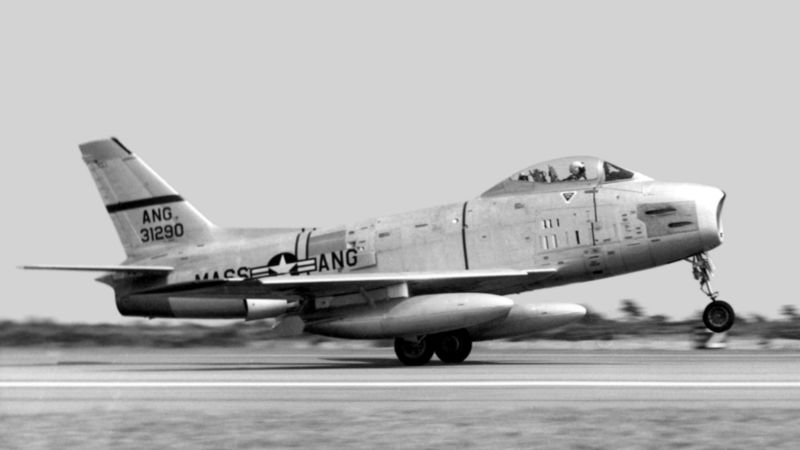
Two F-86H prototypes were built at Inglewood, with the first rolled out in April 1953 and making its first flight in May. The new engine improved performance in all respects, and provided a particularly impressive rate of climb.
The F-86H was intended as a fighter-bomber instead of an air-superiority fighter, and was capable of delivering nuclear weapons, along with conventional bombs, napalm, or rockets. The F-86H had four stores pylons and a LABS systems for nuclear weapons delivery.
___________________________________________________________________
NORTH AMERICAN F-86H SABRE:
___________________________________________________________________
wingspan:
11.92 meters (39 feet 2 inches)
wing area:
29.11 sq_meters (313.37 sq_feet)
length:
11.44 meters (37 feet 6 inches)
height:
4.5 meters (14 feet 9 inches)
empty weight:
4,940 kilograms (10,890 pounds)
loaded weight:
9,234 kilograms (20,357 pounds)
max speed at altitude:
995 KPH (620 MPH / 535 KT)
service ceiling:
15,500 meters (50,800 feet)
range, with drop tanks:
1,675 kilometers (1,270 MI / 1,105 NMI)
___________________________________________________________________
Except for the two prototypes, all F-86Hs were built at the NAA Columbus plant, with three subvariants:
475 F-86Hs were manufactured in all, including the two prototypes. However, the advance of aircraft design at the time was so rapid that even though the F-86H was superior in almost all respects to its F-86A ancestor, it was still obsolescent, and the "Hawg Sabre" or "Sabre Hog" was phased out of first-line service to the Air National Guard by mid-1958. The F-86H would linger in ANG service until the early 1970s. After they had been retired, the US Navy purchased some for "aggressor training" to simulate MiG-17s, though they did not operate for long in this role.
BACK_TO_TOP* The "F-86K" was a simplified version of the F-86D, developed in response to a 1953 USAF request for an export interceptor intended for Western allies under the US Mutual Defense Assistance Program (MDAP).
NAA eliminated the rocket tray in favor of four M24-A-1 20-millimeter cannon, and replaced the complicated E-4 fire-control system with the simpler new MG-4 fire-control system. The E-4 was felt to be unsuitable for export because it was complicated, not very reliable, and top secret. The F-86K sacrificed the collision-course intercept capabilities provided by the E-4 and reverted to the less challenging "tail-chase" intercept. The MG-4 fire-control system used the existing AN/APG-7 radar of the F-86D and could compute efficient tail-chase intercept trajectories.
Installation of the four cannon required a 20-centimeter (8-inch) fuselage stretch forward of the wings. Large vent holes were cut into the cannon bay doors to prevent the gas buildup that had caused so much trouble with the Gunval Sabres. Other than these changes, the F-86K was generally identical to the F-86D-45.
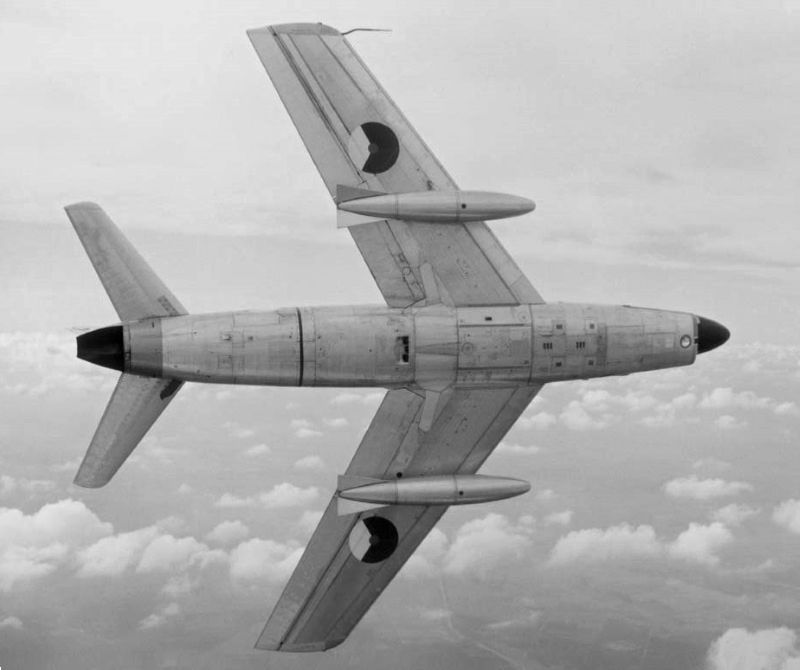
Two F-86D-40s were pulled from production and modified to become "YF-86K" prototypes. First flight was on 15 July 1954, with NAA test pilot Ray Morris at the controls. Original F-86K production was by Fiat of Italy for the Italian Air Force, with 50 kits sent from Inglewood to the Fiat factory in Turin for assembly. The first Italian-assembled F-86Ks went into service in mid-1956, and the type would remain in service with the Italians until 1964. Fiat eventually assembled 221 F-86Ks, with 60 going to France and 88 going to West Germany. In the meantime, NAA had received other contracts for the F-86K and put the type into production at Inglewood, building a total of 120, with deliveries split evenly between Norway and the Netherlands.
Late Fiat production of the F-86K featured the "F-40" long slatted wing, and some Dutch F-86Ks were refitted with this wing. Many F-86Ks were also fitted with two additional stores pylons just outside of the landing gear for Sidewinder missiles. These aircraft were phased out of service in the mid-1960s, generally being sold to other air arms, where they lingered into the 1970s.
* The "F-86L" was developed under "Project Follow-On". It was essentially an F-86D incorporating a data-link capability for the "Semi-Automatic Ground Environment (SAGE)" air-intercept control system.
The CGI system used with the F-86D had not proven entirely satisfactory. Communications between the ground controller and the pilot tended to be slow or confusing, and so something a little smarter was needed. SAGE, introduced in 1953, had been developed by the Lincoln Laboratory at the Massachusetts Institute of Technology (MIT). A SAGE ground center used a big ground-based computer to assess target information obtained by ground radar, and relayed target data to the interceptor through an AN/ARR-39 datalink, automatically guiding the interceptor to the target while the targeting information was displayed to the pilot. It was a marvel of the world at the time -- though it is an indication of the growth of computing power since the 1950s that even though the SAGE computers filled up rooms, being the biggest vacuum-tube computers ever built, any decent modern smartphone would dwarf the memory, mass storage, and processing power of all the SAGE computers put together.
The F-86L was intended as stopgap for SAGE operation until better the better Convair F-102 Delta Dagger -- and then its successor, the superlative F-106 Delta Dart -- came on line. All F-86Ls were rebuilds of low-flight-time F-86Ds, with the first such rebuild flying on 27 December 1955. The rebuilds were brought up to the equivalent of an F-86D-45, with other improvements including updated avionics and the "F-40" long slatted wing. Rebuilt F-86D-50, F-86D-55, and F-86D-60 were simply redesignated "F-86L-50", "F-86L-55", and "F-86L-60" respectively. Oddly, however, earlier F-86D subvariants were given block numbers incremented by 1 after update. For example, an F-86D-40 became an "F-86D-41".
981 F-86Ds were converted to F-86Ls in all. They began to go into USAF Air Defense Command service in late 1957, but were phased out into Air National Guard service by 1960, to be finally obsoleted in 1965.
BACK_TO_TOP